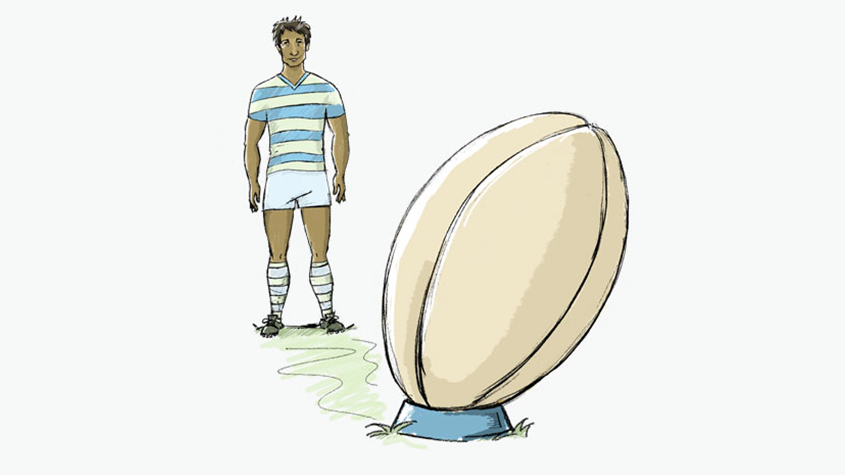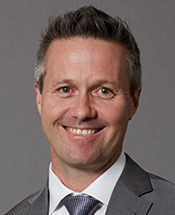
Lining up community and business goals
Adam Check, NRL's head of community, talks with Nick Elliott, director, Consulting about the NRL’s community engagement strategy, practicing what it preaches, and how this helps the bottom line.

- A common narrative can support the focus and alignment of community strategy.
- Authenticity in community engagement is vital; an organisation needs to practice internally what it preaches externally to win credibility.
- Authentic and credible community engagement can create social impact, enhance the organisation’s profile and provide commercial benefits.
In 2014, SVA Consulting assisted the National Rugby League (NRL) to develop a three year strategy for its community portfolio. The project was two-fold: to review the existing community programs and then collectively, with the NRL and the clubs, to define and prioritise the future road map.
Nick Elliott (NE): What were the drivers for the NRL to review its community engagement strategy and what were you looking to achieve with the new strategy that hadn’t been achieved before?

Adam Check (AC): The three reasons that we took stock were: we invested heavily into the communities in which we operate – around $10m across the Game; we knew we needed to narrow and harness that investment; and we couldn’t measure the impact we were having.
We wanted our forward strategy to maximise the social impact we could have. We also believed that as we went about this in an effective way, we could derive commercial benefits for the Game – in all its forms. Fundamentally, we believe that doing good things in community can be beneficial for business – in our case, the Game’s growth.
…how to be more purposeful around the issues that impact both the rugby league family and the community…
The NRL has always had a history of working in the community. It’s intrinsic to our social fabric. But much of our efforts developed organically without any clear direction or sense of what success looks like.
Whether it be Indigenous programs in remote and rural communities or promoting healthy lifestyles to primary school children, our programs are sound. But, on mass, we lacked some cohesion and a narrative to our strategic intent. There was nothing that said this is what the Game stands for in the community and these are the key issues we invest in and why.
We wanted to think through why we’re in the ‘business of community’, which audiences are most relevant to us, and how to be more purposeful around the issues that impact both the rugby league family and the community – issues such as mental health and reconciliation for Aboriginal and Torres Strait Islanders – so that there’s a correlation inside and outside the family.
Fundamentally, we want to be recognised for our contribution to society, as well as the great entertainment we put on the field, knowing it will have a positive return on the numbers of fans and members in the future. This will bring real commercial returns as more people watch, participate and attend the Game – and buy merchandise.
And in delivering commercial returns as a result of our community engagement, we wanted to shape what we do in community – not as a nice to have – but as essential to the Game and its future.
The issues that matter for the NRL
Research and consultation revealed a consensus that a core part of the NRL’s DNA is providing a sense of belonging and opportunity, and the recognition that the NRL can be a community that provides opportunities and is more inclusive.
The process defined the four pivotal target groups – ‘the who’ that the programs and activities need to centre around – as: youth, Indigenous, multi-cultural, and women and girls.
Building on this, the strategy identified four issues to target that are fundamental to the NRL’s identity:
- physical health
- mental health
- social cohesion and eliminating discrimination
- education and employment.
NE: What does success look like and how does this translate into the strategic initiatives that align with, and generate business outcomes for, the Game?
AC: We believe that positive engagement in community issues will enable us to meet our commercial objectives (new fans and members) as well as our social impact.
We realised that we needed to focus on what we do best and, instead of designing and delivering the community programs ourselves…
The strategy identified the ways that the community portfolio will contribute to the commercial objectives either directly through financial outcomes or through growing and sustaining fans and members, and participation in the Game.
We realised that we needed to focus on what we do best and, instead of designing and delivering the community programs ourselves, leverage our resources to attract funding and delivery partners.
Achieving the commercial objectives
The 12 three-year, strategic goals are organised around driving social impact as well as contributing to the commercial objectives through:
- building the Game’s brand and reputation;
- enhancing activities which develop the Game;
- creating avenues for community engagement;
- providing development opportunities for elite players; and
- contributing to financial outcomes through adding value for sponsors as well as new revenue streams.
We want our involvement in the community to be as important as the Game itself. We’ll know that the community engagement strategy is really successful when the NRL and the community both talk about the twin pillars of rugby league as the football itself – the action on the field – and the community programs that we invest in off field.
We’ve done a really good job at identifying the issues that are relevant to our community and to us…
Through our community engagement, we want to leave our custodians, fans, members and the broader community with positive impressions of the Game’s contribution. We know that that will be good for the Game.
We’ve done a really good job at identifying the issues that are relevant to our community and to us, and we’ve started to identify who to partner with to co-design and deliver the programs and activities for maximum impact.
Having chosen the things that matter to us, it feels like we now have a proper belief system and that we can practice what we preach.
State of Mind – our mental health program – is equally about what we do inside the Game, from the elite level to grass-roots, as well as how we work with expert partners to get positive impact in the wider community.
And by engaging our elite players, ambassadors, and staff in programs such as these, there’s a greater understanding of the impact of sound community investment.
The strategy development process
The first part of the process was to review the internal environment: how much money was being spent and where; and then identify best practice and trends internationally in other codes.
The second part was highly consultative: interviewing executives of the NRL, the clubs and state leagues individually and then bringing them together in a workshop to explore what impact they were trying to create and what aligns best with their goals in the future.
SVA Consulting and NRL then developed a strategic narrative around the most important things to do and took this back to the clubs to review. Through this consultation, the project identified the focus areas, target issues and how the NRL would partner and collaborate with funders and providers to make it happen.
NE: What were the most valuable parts of the process?
AC: One of the most valuable parts of the process was the engagement with clubs. We focused specifically on building relationships, communicating regularly and openly about what this might look like and what we need to accomplish together to make it happen. The process has served us really well to get everyone on the same page, especially as we roll into implementation.
One of the most useful discoveries was understanding that even though we were doing so much good stuff, there was no story around it…
For me, the most interesting part was discovering how much the NRL does through its community programs and the potential we have to create more impact. Before I joined a year ago, I would never have known.
Every year, the NRL invests the best part of $10 million in community engagement. It can reach 400,000 kids in a few days through the right programs. A social media campaign around breaking the silence in mental health reaches 6 million people in a heartbeat. Every single club has at least one community engagement manager, some have two, plus there’s a significant unit at Rugby League Central.
One of the most useful discoveries was understanding that even though we were doing so much good stuff, there was no story around it – causing a disconnect; there was no real meaning or belief system around what we do and why we do it, particularly amongst the elite players.
As a result of the new strategy, we’re changing that. With our mental health campaign for example, we’ve started talking to the elite players about why we’re doing what we do and the impact they can have.
NE: What needs to happen to get buy-in to the community engagement strategy?
AC: Really simple: a clear narrative. Some real, measurable impact. And some ‘sound and movement’.
Our 2015 NRL All Stars Indigenous Youth Summit, for example, was unbelievable ‘sound and movement’: 60 Aboriginal and Torres Strait Islander students from Australia gaining a greater appreciation of their culture and getting real life skills from some of Rugby League’s most influential players. Everyone who experienced a piece of that Summit, including our staff, were blown away. It was the ‘wow, I get it’. This kind of involvement is critical.
NE: Is part of getting buy-in about driving commercial results?
AC: Without question. And commercial results does not just mean numbers. We’re becoming more strategic and calculated about how we’re engaging community. We’re taking time to communicate what we stand for and build our credibility before we go to market. It’s important we can quantify and measure this investment in every way. Then people will start to go ‘Ah right, I get what you’re doing’.
This will strengthen the community proposition and our ability to attract investment around it.
NE: How else do you bring together the aspirations of your players (and staff), your aspirations for community impact, and your aspirations for achieving business outcomes?
AC: In addition to alignment and buy-in, the most critical step for the NRL community going forward is getting a clear narrative around why we do what we do.
We need to be able to describe this in a succinct message, so that the CEO, the executive, the commissioners, and the clubs all say the same thing; so that the external overt commitment matches the values and behaviours we stand for in the Game.
Joining the internal and the external, and getting that clear, will make a huge difference.
NE: What’s next?
AC: Execution is king. All 12 strategic goals need to be in play in the next six months so that we can understand what’s working and not working over the next few years – rather than wait for three years to start to understand that.
To do that we need appropriate measurement and evaluation (M&E) to find out if we are having the impact in the designated areas and, if we’re not, what we need to change.
Two parts of research we need:
- Firstly, an immediate M&E piece on our investment in community and what it is achieving so that we have a proof point to talk to government and external investors about the power that the Game has to impact social change.
- Secondly, longitudinal research around the social impact of the NRL’s community strategy. To find out what the NRL does in the community now and then take a pulse check in three, five, and 10 years’ time about what impact it has had; what behaviours have changed in the Game and in society; and how the Game is viewed in the community.
NE: Will being that accountable be scary for some people given you’re so much in the public eye?
AC: With an issue like mental health, which is a big issue for society and has a big impact on the Game, not doing anything is the worst thing.
We’ve got a big powerful voice, big influence. I’m trying to corral that and use that in the right way.
I believe if we pick the right issue, have the right aspirations, are genuine and authentic, and work with the right people, things will happen. And we’ll be accountable.





